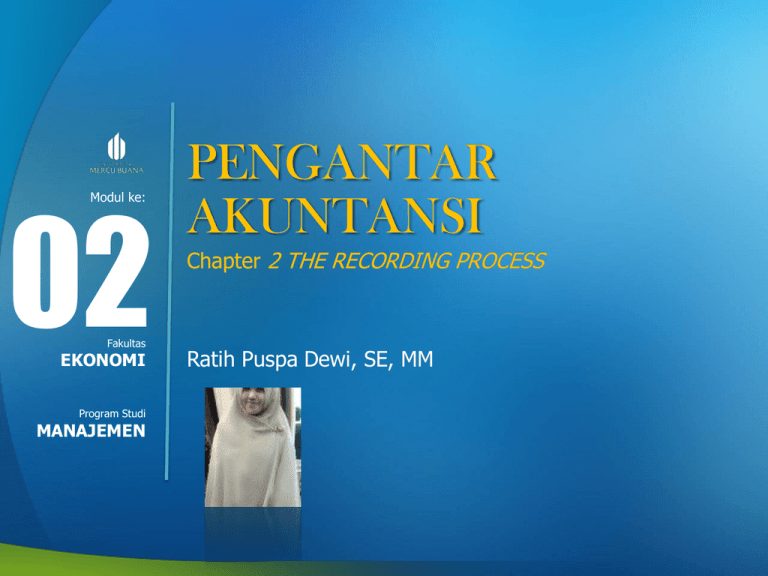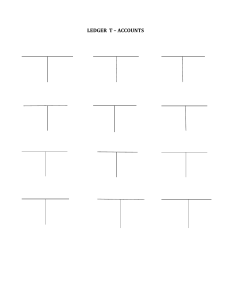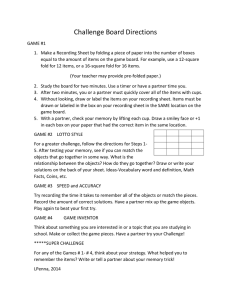
02
Modul ke:
Fakultas
EKONOMI
Program Studi
MANAJEMEN
PENGANTAR
AKUNTANSI
Chapter 2 THE RECORDING PROCESS
Ratih Puspa Dewi, SE, MM
The Recording Process
PENGANTAR AKUNTANS1
PERTEMUAN KE DUA “ THE RECORDING PROCESS
Study Objectives
1.
Explain what an account is and how it helps in the recording
process.
2.
Define debits and credits and explain their use in recording business
transactions.
3.
Identify the basic steps in the recording process.
4.
Explain what a journal is and how it helps in the recording process.
5.
Explain what a ledger is and how it helps in the recording process.
6.
Explain what posting is and how it helps in the recording process.
7.
Prepare a trial balance and explain its purposes.
The Recording Process
The Account
Debits and
credits
Debit and credit
procedure
Equity
relationships
Summary of
debit/credit
rules
Steps in the
Recording
Process
Journal
Ledger
Posting
The Recording
Process
Illustrated
Summary
illustration of
journalizing and
posting
The Trial Balance
Limitations of a
trial balance
Locating errors
Use of currency
signs
The Account
Record of increases and decreases in
a specific asset, liability, equity,
revenue, or expense item.
Account
Debit = “Left”
Credit = “Right”
An Account can be
illustrated in a TAccount form.
Account Name
Debit / Dr.
Credit / Cr.
SO 1 Explain what an account is and how it helps in the recording process.
The Account
Debits and Credits
Double-entry accounting system
Each transaction must affect two or more accounts to keep the basic
accounting equation in balance.
Recording done by debiting at least one account and crediting another.
DEBITS must equal CREDITS.
SO 2 Define debits and credits and explain their
use in recording business transactions.
Debits and Credits
If Debits are greater than Credits, the account will have a debit
balance.
Account Name
Debit / Dr.
Credit / Cr.
Transaction #1
$10,000
$3,000
Transaction #3
8,000
Balance
Transaction #2
$15,000
SO 2 Define debits and credits and explain their
use in recording business transactions.
Debits and Credits
If Credits are greater than Debits, the account will have a credit
balance.
Account Name
Transaction #1
Balance
Debit / Dr.
Credit / Cr.
$10,000
$3,000
Transaction #2
8,000
Transaction #3
$1,000
SO 2 Define debits and credits and explain their
use in recording business transactions.
Debits and Credits Summary
Liabilities
Normal
Balance
Debit
Assets
Credit / Cr.
Normal Balance
Chapter
3-24
Equity
Credit / Cr.
Debit / Dr.
Debit / Dr.
Normal
Balance
Credit
Debit / Dr.
Credit / Cr.
Normal Balance
Normal Balance
Chapter
3-23
Expense
Debit / Dr.
Revenue
Chapter
3-25
Credit / Cr.
Debit / Dr.
Normal Balance
Chapter
3-27
Credit / Cr.
Normal Balance
Chapter
3-26
SO 2
Debits and Credits Summary
Balance Sheet
Asset
=
Income Statement
Liability + Equity
Revenue - Expense
Debit
Credit
SO 2 Define debits and credits and explain their
use in recording business transactions.
Debits and Credits Summary
Review Question
Debits:
a. increase both assets and liabilities.
b. decrease both assets and liabilities.
c. increase assets and decrease liabilities.
d. decrease assets and increase liabilities.
Solution
notes page
SO 2 Define debits and credits and explain their
use in recording business transactions.
Assets and Liabilities
Assets
Debit / Dr.
Credit / Cr.
Assets - Debits should
exceed credits.
Normal Balance
Liabilities – Credits
should exceed debits.
Chapter
3-23
Liabilities
Debit / Dr.
Credit / Cr.
The normal balance is on
the increase side.
Normal Balance
Chapter
3-24
SO 2 Define debits and credits and explain their
use in recording business transactions.
Equity Relationships
Issuance of share capital and
revenues increase equity
(credit).
Equity
Debit / Dr.
Credit / Cr.
Dividends and expenses
decrease equity (debit).
Normal Balance
Chapter
3-25
Retained Earnings
Share Capital
Debit / Dr.
Credit / Cr.
Debit / Dr.
Normal Balance
Chapter
3-25
Chapter
3-25
Dividends
Credit / Cr.
Debit / Dr.
Normal Balance
Normal Balance
Credit / Cr.
Chapter
3-23
SO 2 Define debits and credits and explain their
use in recording business transactions.
Revenue and Expense
Revenue
Debit / Dr.
Credit / Cr.
Normal Balance
Chapter
3-26
Expense
Debit / Dr.
Credit / Cr.
The purpose of earning
revenues is to benefit the
shareholders.
The effect of debits and credits
on revenue accounts is the same
as their effect on equity.
Expenses have the opposite
effect: expenses decrease equity.
Normal Balance
Chapter
3-27
SO 2 Define debits and credits and explain their
use in recording business transactions.
Summary of Debit/Credit Rules
Relationship among the assets, liabilities and equity of a
business:
Illustration 2-12
The equation must be in balance after every transaction. For
every Debit there must be a Credit.
SO 2 Define debits and credits and explain their
use in recording business transactions.
Summary of Debit/Credit Rules
Review Question
Accounts that normally have debit balances are:
a. assets, expenses, and revenues.
b. assets, expenses, and retained earnings.
c. assets, liabilities, and dividends.
d. assets, dividends, and expenses.
Solution
notes page
SO 2 Define debits and credits and explain their
use in recording business transactions.
Summary of Debit/Credit Rules
Kathy Renee Browne, president of Hair It Is
Company has just rented space in a shopping
mall in which she will open and operate a beauty salon. A friend
has advised Kathy to set up a double-entry set of accounting
records in which to record all of her business transactions.
Following are the accounts that Hair It Is Company, will likely
need to record the transactions. Indicate whether the normal
balance of each account is a debit or a credit.
Cash
Debit
Equipment
Debit
Supplies
Debit
Accounts payable
Credit
Notes payable
Credit
Share capital
Credit
Solution on
notes page
SO 2 Define debits and credits and explain their
use in recording business transactions.
Steps in the Recording Process
Illustration 2-13
Analyze each transaction
Enter transaction in a journal
Transfer journal information to
ledger accounts
Business documents, such as a sales slip, a check, a bill, or
a cash register tape, provide evidence of the transaction.
SO 3 Identify the basic steps in the recording process.
Steps in the Recording Process
Journalizing
Book of original entry.
Transactions recorded in chronological order.
Contributions to the recording process:
1. Discloses the complete effects of a transaction.
2. Provides a chronological record of transactions.
3. Helps to prevent or locate errors because the debit
and credit amounts can be easily compared.
SO 4 Explain what a journal is and how it helps in the recording process.
Steps in the Recording Process
Journalizing - Entering transaction data in the journal.
Illustration: On September 1, stockholders invested $15,000
cash in exchange for ordinary shares, and Softbyte
purchased computer equipment for $7,000 cash.
Illustration 2-14
General Journal
Date
Sept. 1
Account Title
Cash
Ref.
Debit
15,000
Share capital
Computer equipment
Cash
Solution on
notes page
Credit
15,000
7,000
7,000
SO 4
Steps in the Recording Process
Simple and Compound Entries
Illustration: On July 1, Butler Company purchases a
delivery truck costing $14,000. It pays $8,000 cash now and
agrees to pay the remaining $6,000 on account.
Illustration 2-15
General Journal
Date
Account Title
Sept. 1
Delivery equipment
Solution on
notes page
Ref.
Debit
Credit
14,000
Cash
8,000
Accounts payable
6,000
SO 4
Steps in the Recording Process
The Ledger
General Ledger
All accounts maintained by a company.
All asset, liability, equity, revenue and expense accounts.
Illustration 2-16
SO 5 Explain what a ledger is and how it helps in the recording process.
Answer on
notes page
SO 5 Explain what a ledger is and how it helps in the recording process.
The Ledger
Standard Form of Account
T-account form used in accounting textbooks.
Ledger form used in practice.
Illustration 2-17
SO 5 Explain what a ledger is and how it helps in the recording process.
The Ledger
Chart of Accounts
Illustration 2-18
SO 5 Explain what a ledger is and how it helps in the recording process.
Postin
gPosting – the
process of
transferring
amounts from
the journal to
the ledger
accounts.
Illustration 2-19
SO 6 Explain what posting is and how it helps in the recording process.
The Recording Process Illustrated
Follow these steps:
.
Determine what
type of account
is involved.
2. Determine what
items increased
or decreased and
by how much.
3. Translate the
increases and
decreases into
debits and
credits.
Illustration 2-20
SO 6 Explain what posting is and how it helps in the recording process.
The Recording Process
Illustrated
Illustration 2-21
SO 6 Explain what posting is and how it helps in the recording process.
The Recording Process
Illustrated
Illustration 2-22
SO 6
The Recording Process
Illustrated
Illustration 2-23
SO 6
The Recording Process
Illustrated
Illustration 2-24
SO 6
The Recording Process
Illustrated
Illustration 2-25
SO 6
The Recording Process
Illustrated
Illustration 2-26
SO 6 Explain what posting is and how it helps in the recording process.
The Recording Process
Illustrated
Illustration 2-27
SO 6
The Recording Process
Illustrated
Illustration 2-28
SO 6
The Recording Process
Illustrated
Illustration 2-29
SO 6
Posting
Review Question
Posting:
a.
normally occurs before journalizing.
b.
transfers ledger transaction data to the journal.
c.
is an optional step in the recording process.
d.
transfers journal entries to ledger accounts.
Solution on
notes page
SO 6 Explain what posting is and how it helps in the recording process.
The Recording Process Illustrated
Katherine Turner recorded the following
transactions during the month of March.
Post these entries to the Cash account.
Solution on
notes page
SO 6
The Trial Balance
Illustration 2-32
A list of accounts
and their
balances at a
given time.
Purpose is to
prove that debits
equal credits.
SO 7 Prepare a trial balance and explain its purposes.
The Trial Balance
Limitations of a Trial Balance
The trial balance may balance even when
1. a transaction is not journalized,
2. a correct journal entry is not posted,
3. a journal entry is posted twice,
4. incorrect accounts are used in journalizing or
posting, or
5. offsetting errors are made in recording the amount
of a transaction.
SO 7 Prepare a trial balance and explain its purposes.
Answer on
notes page
SO 7 Prepare a trial balance and explain its purposes.
The Trial Balance
The accounts
come from the
ledger of
Christel
Corporation at
December 31,
2011.
Solution on
notes page
Christel Corporation
Trial Balance (in thousands)
December 31, 2011
SO 7
Understanding U.S. GAAP
Key Differences
The Recording Process
Rules for accounting for specific events sometimes differ
across countries. For example, IFRS companies rely less on
historical cost and more on fair value than U.S. companies.
Despite the differences, the double-entry accounting system is
the basis of accounting systems worldwide.
Both the IASB and FASB go beyond the basic definitions
provided in this textbook for the key elements of financial
statements, that is, assets, liabilities, equity, revenues, and
expenses. The more substantive definitions, using the FASB
definitional structure, are provided in the Chapter 1
“Understanding U.S. GAAP” section.
Understanding U.S. GAAP
Key Differences
The Recording Process
A trial balance under GAAP follows the same format as shown
in the textbook.
In the United States, equity is often referred to as either
shareholders’ equity or stockholders’ equity, and Share
Capital—Ordinary is referred to as Common Stock. The
statement of financial position is often called the balance sheet
in the United States.
Understanding U.S. GAAP
Looking to the Future
The Recording Process
The basic recording process shown in this textbook is followed by
companies across the globe. It is unlikely to change in the future.
The definitional structure of assets, liabilities, equity, revenues,
and expenses may change over time as the IASB and FASB
evaluate their overall conceptual framework for establishing
accounting standards.
Copyright
Copyright © 2011 John Wiley & Sons, Inc. All rights reserved.
Reproduction or translation of this work beyond that permitted in
Section 117 of the 1976 United States Copyright Act without the
express written permission of the copyright owner is unlawful.
Request for further information should be addressed to the
Permissions Department, John Wiley & Sons, Inc. The purchaser
may make back-up copies for his/her own use only and not for
distribution or resale. The Publisher assumes no responsibility for
errors, omissions, or damages, caused by the use of these
programs or from the use of the information contained herein.
Terima Kasih
Ratih Puspa Dewi,SE,MM









